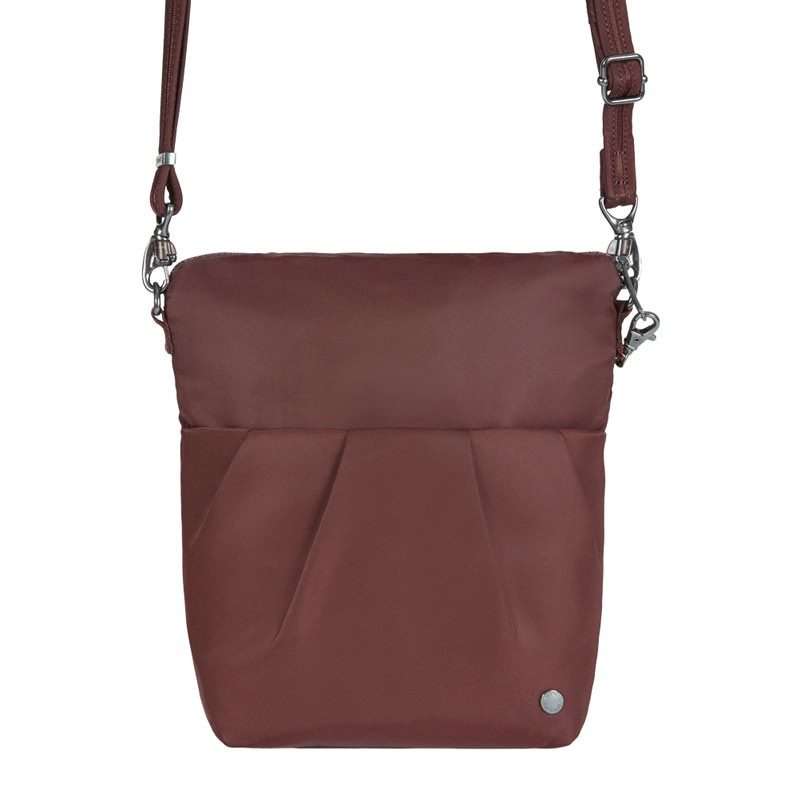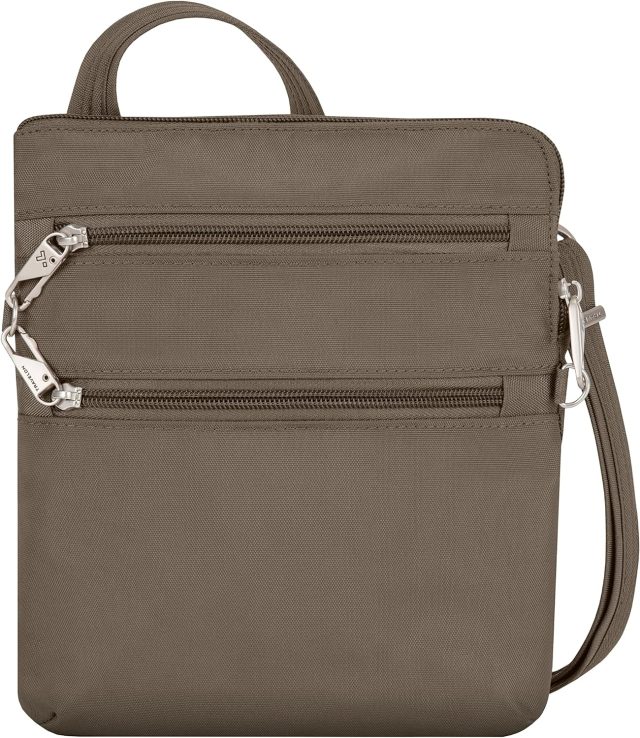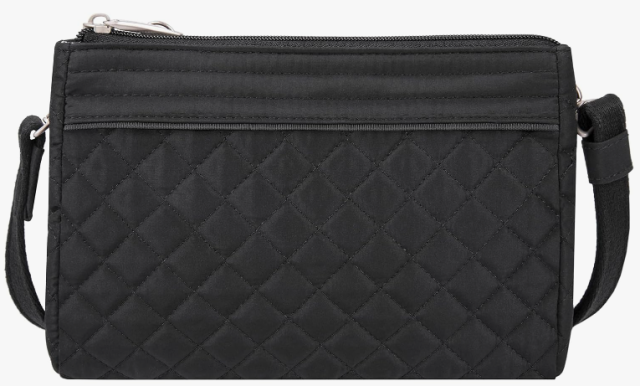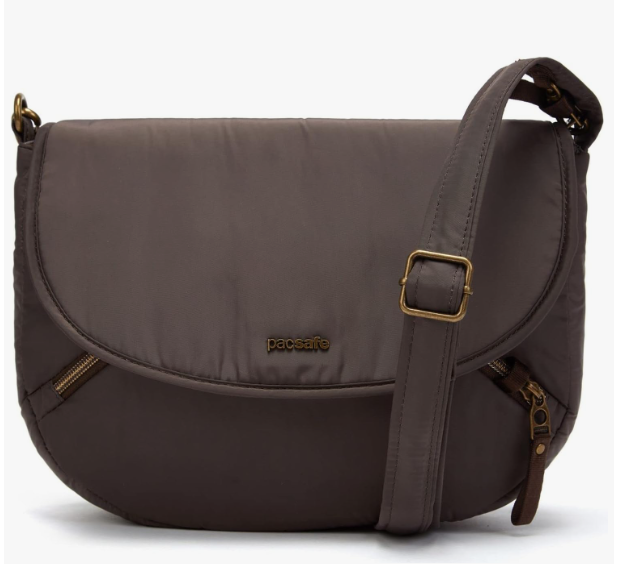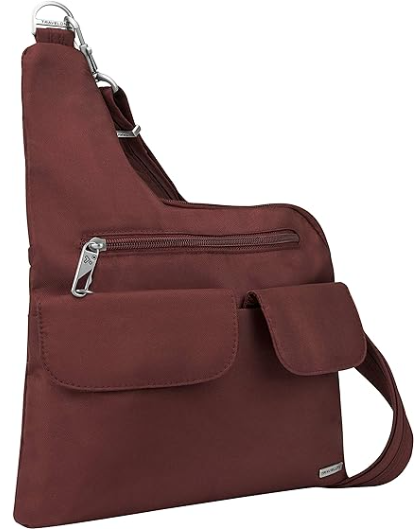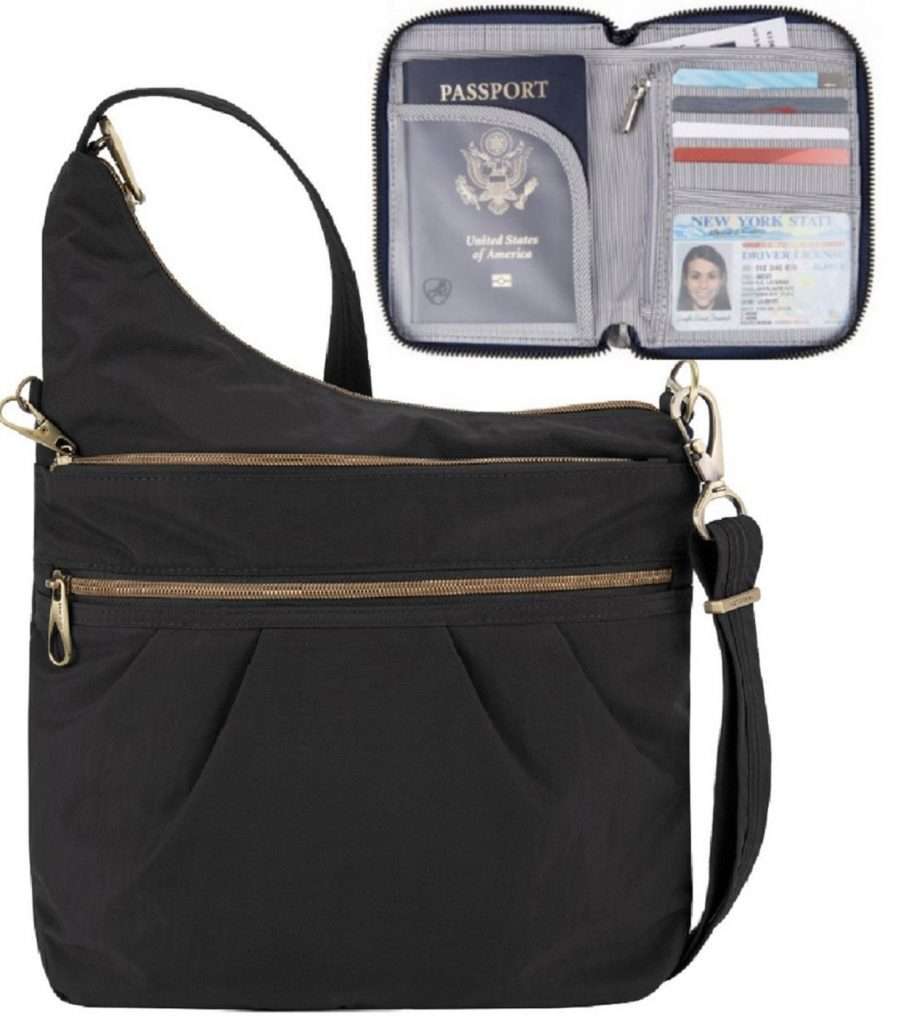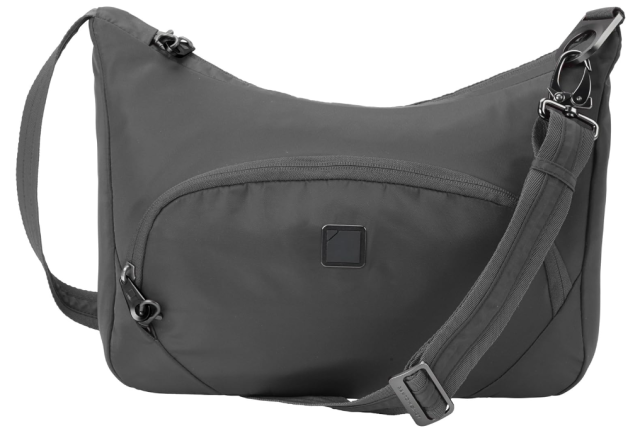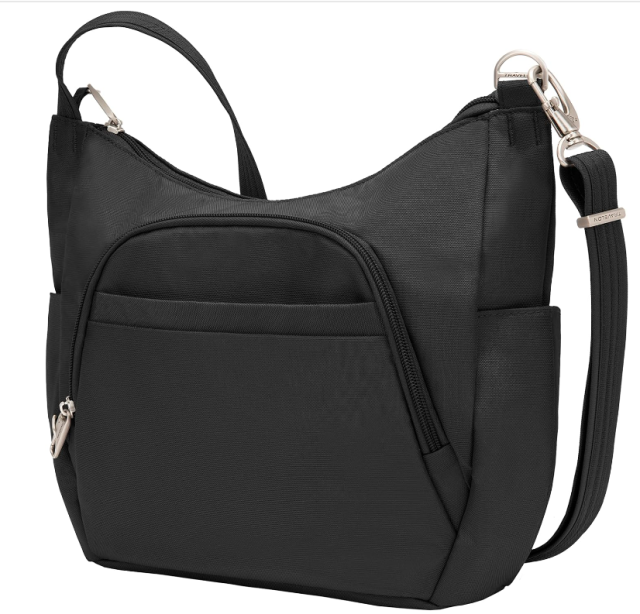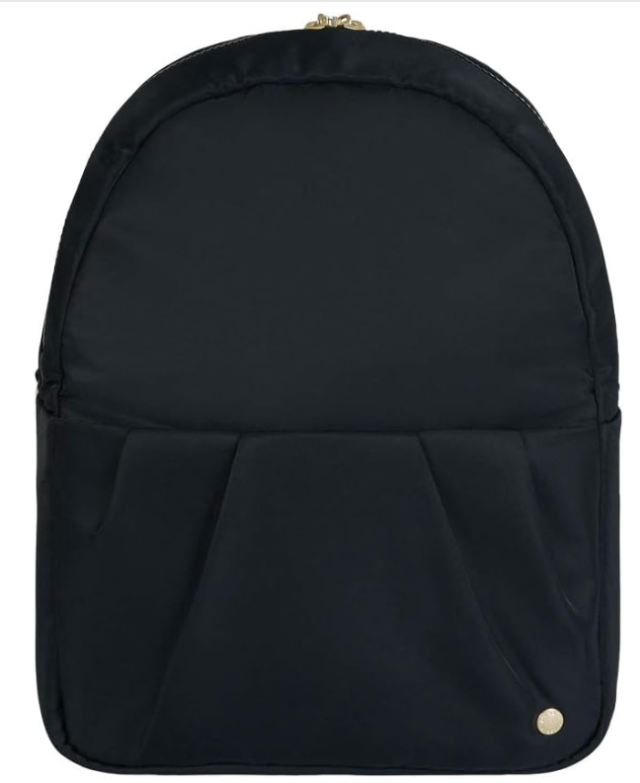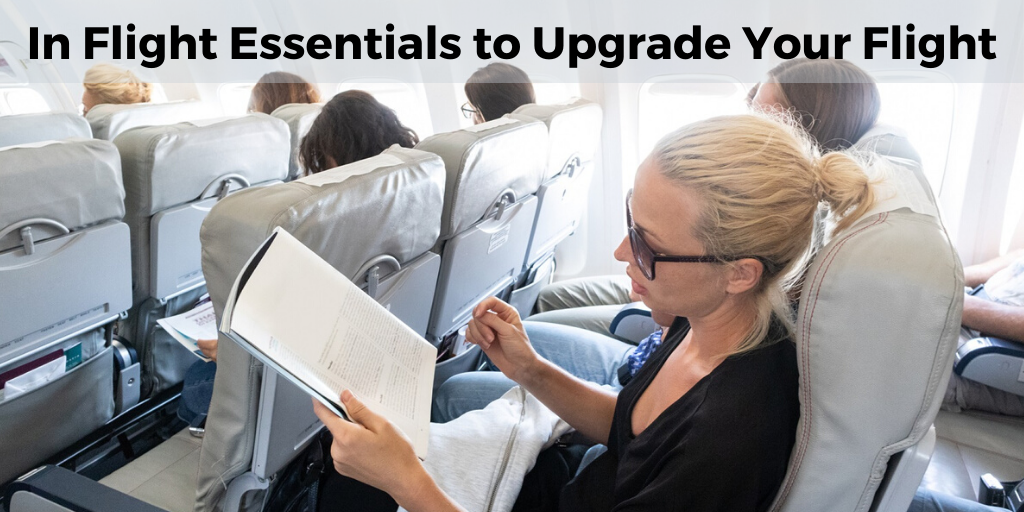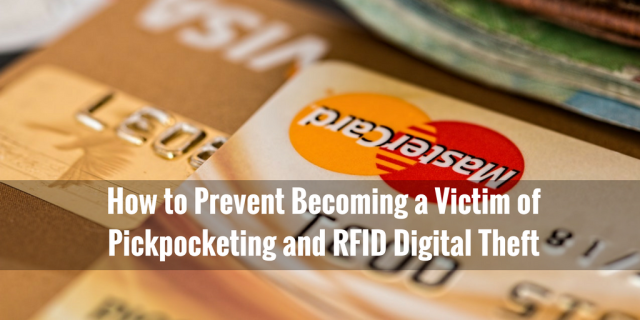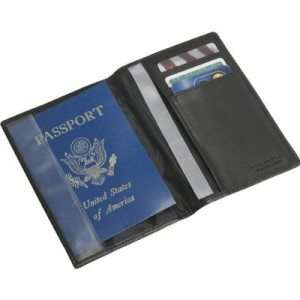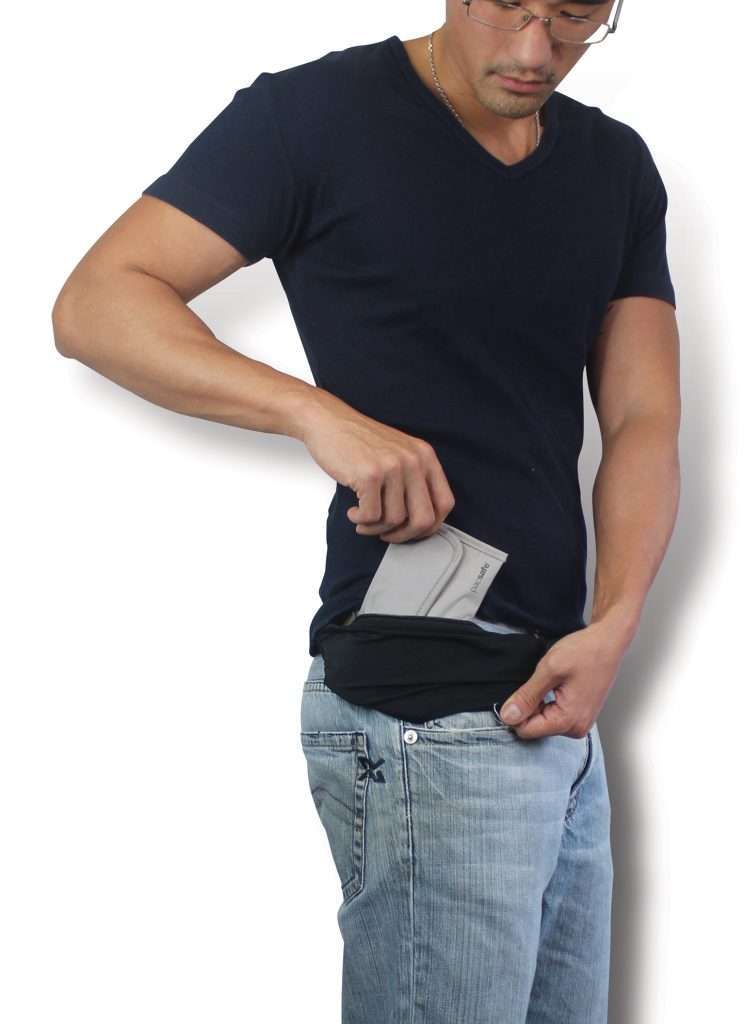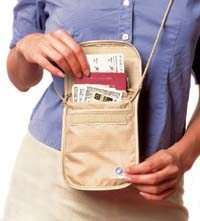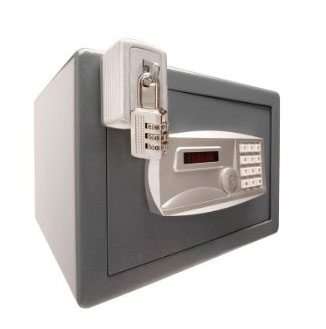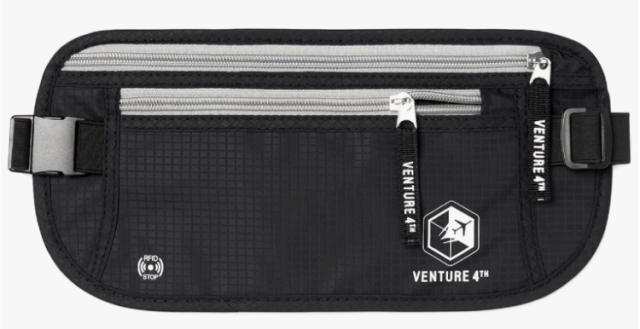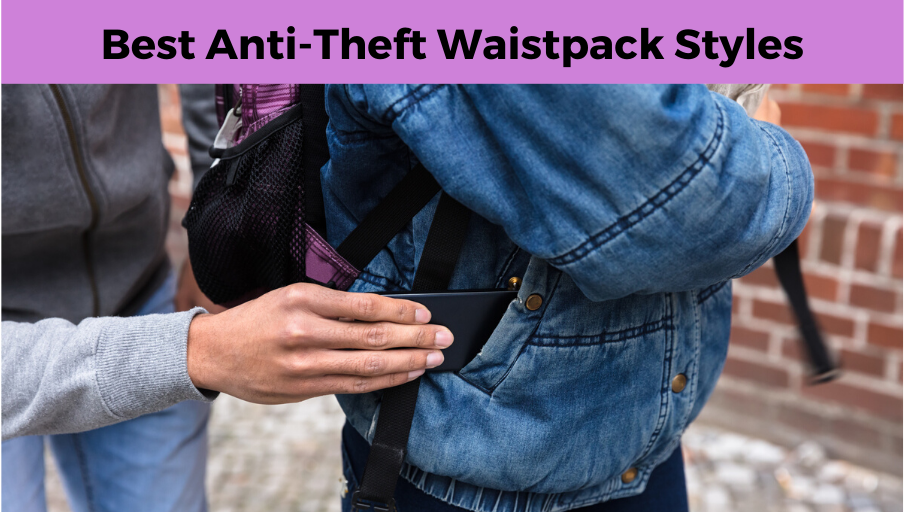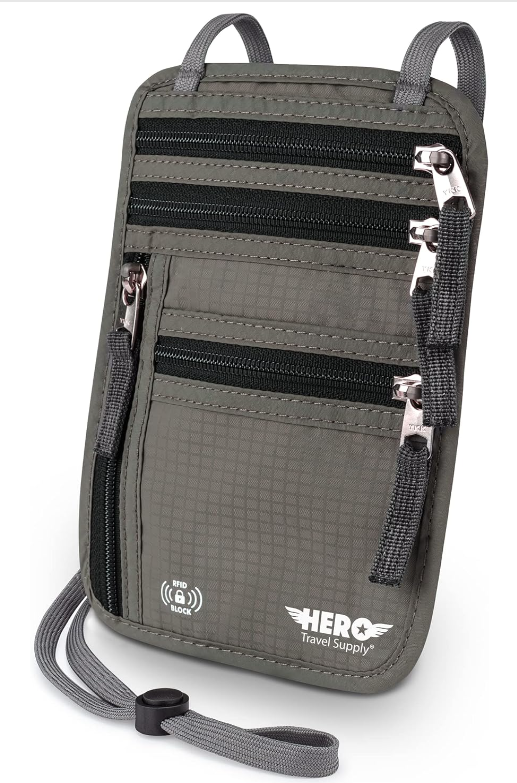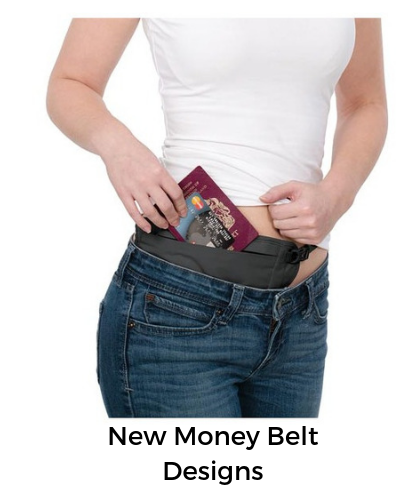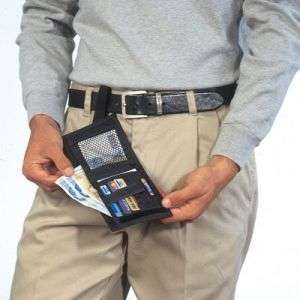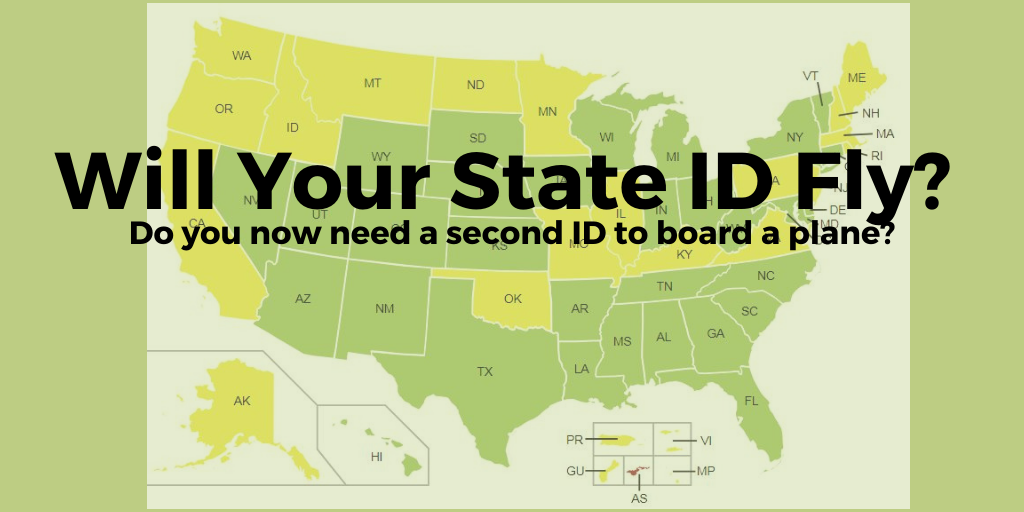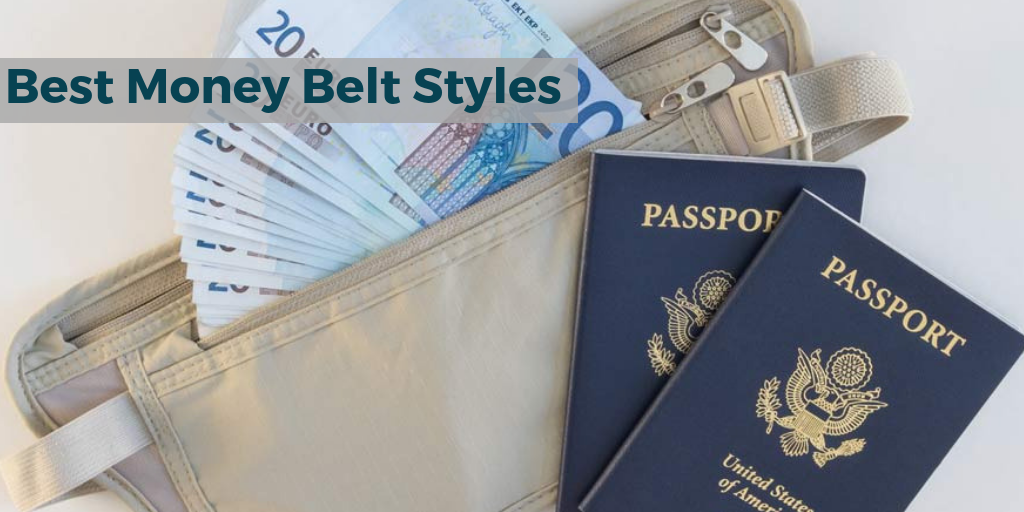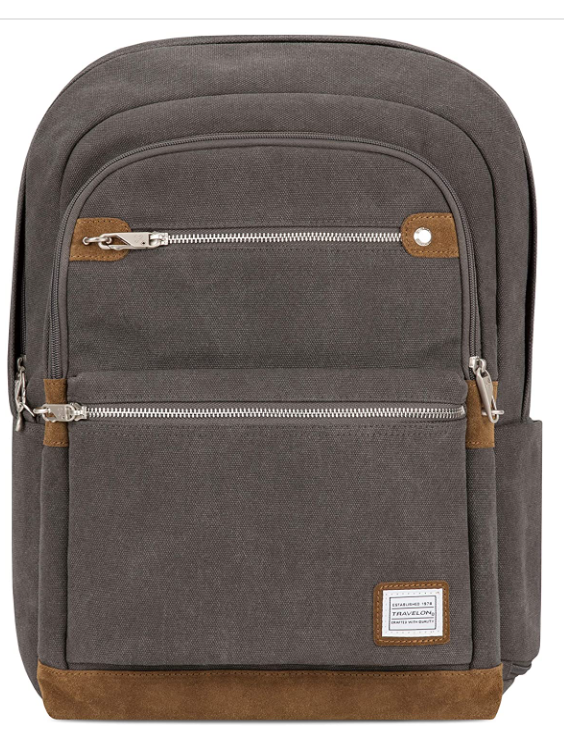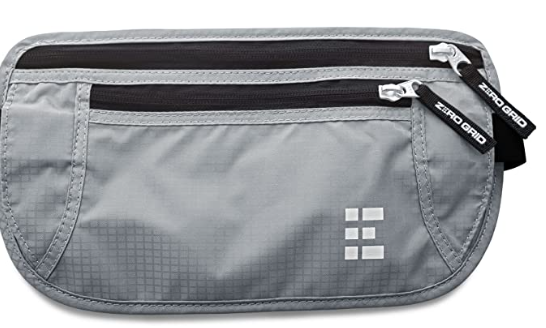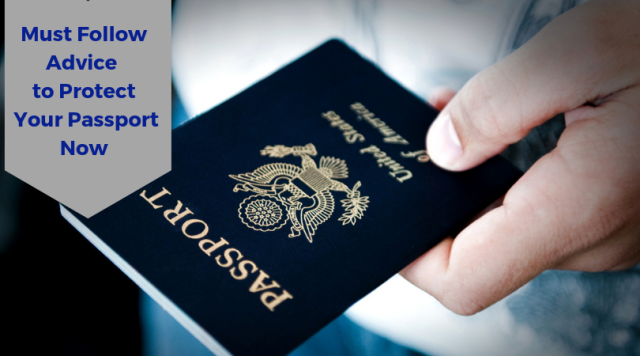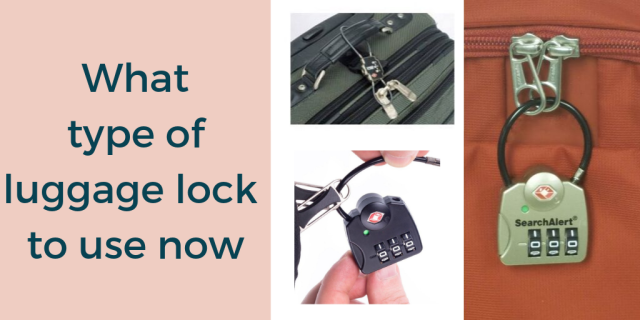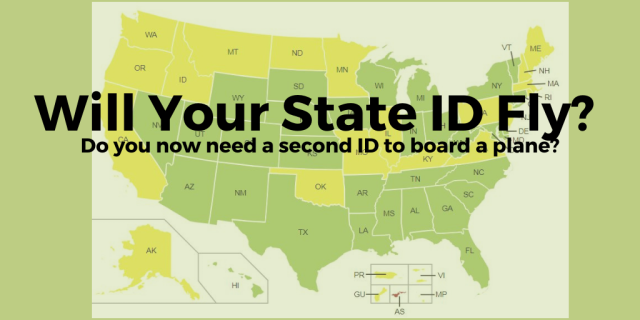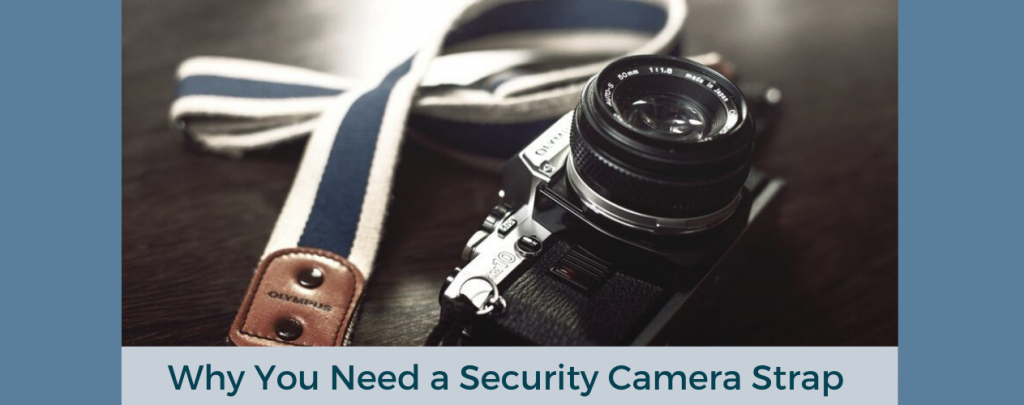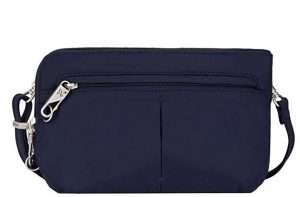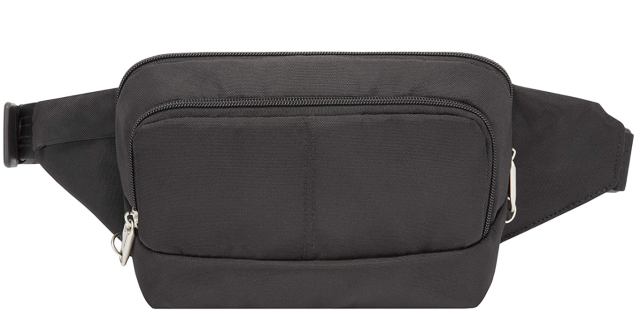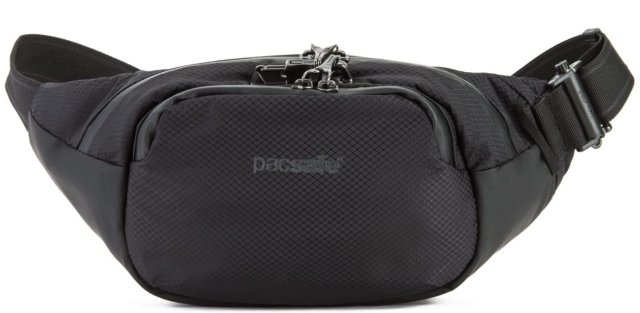Looking for an anti-theft crossbody handbag for travel? If you’re planning on traveling finding an anti-theft crossbody handbag is a must. Today’s bags are so well designed that they are a popular choice for nontravelers for use as an everyday bag too. Anti-theft crossbody bags or purses look like regular bags or purses however, their discreet built-in security features will let you enjoy even the most crowded tourist attractions with peace of mind knowing that your valuables are secure. Anti-theft crossbody travel bags are practical, comfortable, and can keep your belongings safe from pickpockets with built-in anti-theft features.
The crossbody feature keeps your hands free and the bag secure on your body. The best way to carry your anti-theft crossbody travel purse is so it hangs a little bit in front of you and not bouncing on your back. This provides even more security from street thieves and pickpockets.
Good Anti-Theft Crossbody Handbags for Travel have:
A zipper closure that locks down. The number one feature to keep the hands of a pickpocket out of your bag is a zipper with a zipper pull that locks down with a clip to prevent it from being pulled open. Both Pacsafe and Travelon Bags offer this as a standard issue on their travel bags.
A hidden flexible wire in the strap. A flexible wire embedded in the bag strap prevents slice-and-run theft. Slice-and-run thefts typically happen more in crowds and busy tourist locations. Have peace of mind knowing your strap is slice-resistant.
A panel of wire mesh. Fused in the lower portion of the bag should be a wire mesh that stops bag slashers from cutting through your bag. The most vulnerable part of any bag for this type of crime is the lower and lower sides of the bag. Thieves who cut bags are looking for the bag contents to fall out into the awaiting hands before running off with them.
A pocket with RFID protection. Passports and credit cards contain your personal information embedded inside them. This information can be read by hand-held RFID readers up to 10 feet away and even through your bag. Store your credit cards and passport inside an RFID-blocking pocket of your bag to shield your personal data from theft.
What size handbag are you looking for long & skinny, small, medium, or large? Be like Goldilocks and find the right size for your next trip. Each size can hold a different number of items but they’re all anti-theft to safeguard your valuables.
Long & Skinny Anti-Theft Crossbody Handbags for Travel
1. Citysafe CX Anti-Theft Convertible Crossbody
This stylish anti-theft crossbody bag converts in size when you need it. The Citysafe CX Anti-Theft Convertible Crossbody expanded bag fits a tablet, as seen below. Folded down it’s perfect for an evening out. This bag definitely does double duty. As with all Pacsafe bags, this bag has built-in security features to deter thieves, including digital or e-thieves.
2. Anti-Theft Classic Slim Double Zip Crossbody Bag
This Anti-Theft Classic Slim Double Zip Crossbody hugs your body comfortably. The roomy zip compartment is well thought out with RFID blocking card and passport slots, an open-top wall pocket, a zip wall pocket, and a tethered key clip with LED light. Two locking zip pockets on the front are perfect for keys, lipstick, tickets and other quick-grab items. The rear snap close pocket holds a map, book, or sunglasses. Travel securely and confidently with Travelon’s anti-theft features including slash-resistant construction, locking compartments, slash-resistant and locking straps to keep you and your belongings protected
Small Anti-Theft Crossbody Handbags for Travel
3. Anti-theft Signature Quilted E/W Slim Bag
The Travelon Anti-Theft Signature Quilted E/W Slim Bag is perfect for carrying more than just the essentials. Two styles in one bag. It’s a clutch and cross body bag, depending on the strap you choose. Whether you’re off to work or a day of running errands, you’ll love keeping everything you need in an organized manner. The roomy main compartment features a zippered wall pocket, a tethered key clip with LED light, two drop pockets that are perfect for frequently needed items plus opens wide providing full access. The front locking zipper compartment has a zippered wall pocket, RFID protected Passport pocket and 5 RFID card slots plus room to hold additional items. The front slash pocket keeps your phone accessible and easy to locate. The rear zipper compartment is perfect for travel documents and can hold an iPad Mini. With Anti-Theft features like locking zippers, slash resistant, adjustable straps and body panels and RFID protection that keeps your identity secure from high-tech electronic readers, you can travel safely and securely. This Crossbody bag effortlessly integrates a signature style and is an excellent addition to your accessory collection.
4. Travelon Anti-Theft Boho Slim Crossbody Bag
VIDEO: Perfectly sized, the Anti-Theft Boho Slim Crossbody Bag will go with you long after your travels are over. The locking main compartment has RFID blocking technology to stop e-thieves from reading your personal information embedded in credit cards and passports. Well thought out compartments will keep your essentials organized and handy and the adjustable slash-resistant strap secures to a stationary object to prevent grab and go theft.
5 Pacsafe Stylesafe Anti-Theft Crossbody
This Pacsafe bag has an RFID-blocking pocket that protects the personal info embedded in your passport and credit cards plus all the other security features you’ve come to expect from Pacsafe. You’ll keep using this bag long after your trip is over. CAN BE LOCKED TO FIXTURES – With an adjustable, wire-reinforced anchor strap, the crossbody bag can be secured around a table or chair to keep your belongings secure, to protect your wallet, passport, laptop/tablet and phone where items need to be left unattended.
Medium Anti-Theft Crossbody Handbags for Travel
6. Anti-Theft Classic Crossbody Bag with RFID Protection
The Travelon Anti-Theft Crossbody RFID Blocking Bag is a great travel bag when you want style with security and hands-free convenience. Its slim profile and crossbody design is comfortable and looks fashionable no matter what the season, expressly designed to be worn the most secure way which is slung across your body.
7. Anti-theft Signature Quilted Expansion Cross Body Bag
A locking zippered roomy main compartment allows you to take more than just the basics with you. It features 5 RFID blocking card slots, a RFID Passport pocket, a large zippered wall pocket plus a slash pocket that is ideal for glasses, a smartphone or other frequently needed items. It can even fit an iPad. The long, cut-resistant, adjustable strap lets you carry the bag as a crossbody for hands-free convenience, or traditionally over your shoulder. The swivel clasp allows the strap to move freely and it can also be attached to a stationary object to prevent a grab-n-go. With 2 front-locking zippered pockets, a deep rear zippered pocket and a tethered key clip that allows you to easily locate your keys you will be well organized. Made from durable water & stain resistant nylon and accented in gorgeous antique brass finished hardware.
Travelon Anti-theft Boho Square Crossbody, MORE COLORS
8. Anti-Theft Signature 3 Compartment Crossbody Bag
The Anti-Theft Signature 3 Compartment Crossbody Bag is a lightweight bag that features 3 locking compartments to provide discreet, yet highly effective protection against pickpockets. The signature pleats on the front & brushed brass zipper accents, add style & and a fashion-forward look, fooling anyone into thinking this is just an everyday bag! The coordinating RFID-blocking travel wallet like the purse can be used long after your trip is over.
9. Secura™ RFID-Blocking Anti-Theft Cross-Body
This medium-sized bag infuses style and security into what will be your favorite travel bag. Lightweight and with decorative hardware that does double duty as built-in security features. One opening to secure and to hold your essentials for peace of mind. This travel bag is equipped with RFID protected card slots and locking zippers. The adjustable shoulder strap and bag panels contain stainless steel cable and magnaloft fabric providing anti-slash, anti-theft security. Exterior locking pocket for your cell phone. Plenty of room in the interior zipper pockets to safely store your passport, wallet, keys, and more.
Large Anti-theft Crossbody Handbags for Travel
10. Anti-Theft Cross-Body Bucket Bag
This lightweight cross-body bucket bag is very comfortable to wear, it offers a slash-proof strap that can be attached to a post or table with ease. Great size for carrying everyday items as well as a small iPad or reader. The front and main locking compartments offer slash-proof construction for peace of mind along with the RFID reader blocking card slots. The outside mesh panels easily store a water bottle and umbrella. Locking main compartment plus an organization compartment with RFID blocking card and passport slots. Slash-resistant body and adjustable, slash-resistant shoulder strap attaches to chair or post. Front slash pocket, zip rear pocket and removable LED light.
11. Women’s Citysafe CX Anti Theft Convertible Backpack-Fits 10″ Tablet
Two stylish anti-theft bags in one – the city safe CX convertible backpack can be worn as a backpack or fold down to sling over your shoulder as a handbag. There’s room for a wallet, cosmetics case, and more, with zipper security and a cut-resistant anchor strap to keep everything protected.
Final thought for finding a best-selling anti-theft crossbody handbag for travel
When reviewing the various best sellers of travel bags, be sure to focus on anti-theft crossbody handbags for travel. These are proven favorites by seasoned and infrequent travelers alike. Consider if you’ll need a bag that accommodates an umbrella or water bottle or a bag that just keeps your travel wallet, phone, or small camera safe. One tip when looking at bags online is to have a ruler and one of your current handbags for comparing sizes.



